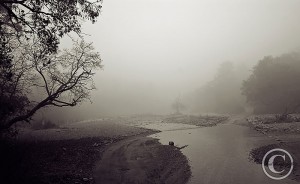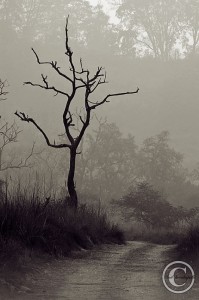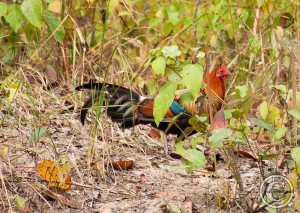From Corbett To Keoladeo
(Note: This trip report was first published in the April 2009 edition of Bird watchers’ Society of Andhra Pradesh’s newsletter-Pitta. An edited version of this post was featured in You & I Magazine.)
They say that you can never forget your first tiger sighting in the wild. The majestic walk, the earth shattering roar and the easy but arrogant confidence apparently imprint him in your mind forever. With such descriptions and statements in mind I set off back in late January 2009, to the Jim Corbett National Park in Ramnagar, Uttarakhand to join that relatively small club of people who have seen the magnificent beast in the wild. While two days of frantic dashes and sudden hushed stops throughout the length and breadth of the Brijrani area of the park did not yield even a small glimpse of that much praised animal (except for some fresh pugmarks), in all those wanderings I did get to see an amazing variety of bird life both in Corbett and a few days later in the Keoladeo Ghana National Park in Bharatpur, Rajasthan. And in the latter I saw a sight that completely drove the tiger from my mind. It was the most beautiful bird I had ever seen in my short birding career. But more about this bird and the Bharatpur sanctuary later. Let me first guide you through the foggy grasslands, thin gurgling streams and cool woodlands of Corbett by conveniently concentrating on birding aspects of the trip and ignoring for most part our increasingly desperate attempts to spot a tiger.
We reached Ramnagar too early to enter the park so our jeep driver took us to the Kosi river to pass time. It was still dark but a thin light was breaking out in the east marginally illuminating the murky riverbed that was mostly dry except for a small flow. As we stumbled over the smooth and rounded pebbles of the river bed, a sudden clear ringing rent the perfectly still dawn air. It was the di-geri-doo call of a lapwing. Although it was still too dark to see the bird. I wanted to hang around a bit for the light to brighten to identify the lapwing and see if there were any more birds but it was time to proceed to the park.
As we waited to collect our park entry permits at the Brijrani gate and be assigned a guide we saw that ubiquitous septet, the Jungle Babblers (Turdoides striatus) hopping around. After we proceeded into the park, as soon as we passed the buffer zone and were crossing a shallow stream we saw a Red-wattled Lapwing (Vanellus indicus) running away from us. After crossing the stream and climbing the crest of a small mound we found a rivulet below on our left in which we observed through the rapidly thinning fog a group of Black Storks (Ciconia nigra) out fishing early. We continued towards the canteen at the beginning of the park proper to quieten our grumbling stomachs. Stomach filled, I was sipping on some hot Bournvita when I spied a little bird hopping around the tables in front of the canteen with its tail raised. It was a White-Capped Water Redstart (Chaimarrornis leucocephalus), a bird I did not expect to be so used to civilization.
No sooner had we left the canteen, our guide Mahesh pointed out a Lesser Flameback Woodpecker (Dinopium benghalense) in the distance seemingly bent on breaking its beak on the bark of a tree. As we were driving through a wooded area we heard the harsh bark of an Indian Muntjac (Muntiacus muntjak) from near us and stopped by the side of the track to investigate. A flash of color in the dense bushes next to us sent our pulses racing. Alas, it was not a tiger passing through. It was only a “lowly” timid Red Junglefowl (Gallus gallus) giving us the once over with its bobbing head!
Towards late afternoon we made our way towards the Malani region of the park to catch a glimpse of the core forest area that no day visitors are allowed to enter even with entry permits. Mahesh, sharp as ever, pointed out a group of birds in the distance sitting high in the branches of a tree well above the average tree cover. Their bare, red colored fleshy necks gave them away instantly. It was a group of Red-Headed Vultures (Sarcogyps calvus) seemingly relaxing under the late afternoon sunshine.
After tempting me throughout the day among the many grasslands that litter the park, I finally managed to get a good close-up photo of a Grey Bushchat (Saxicola ferrea) as we made our way back to the main gate. Just before we passed into the buffer zone, Mahesh spotted a lone bird atop a tree in the distance. He identified it as a Oriental Pied Hornbill (Anthracoceros albirostris) which we soon confirmed through the good offices of the zoom button on my camera. And with that ended our first day in the Corbett National Park.
After a good night’s sleep in a camp on the banks of the Kosi river a few kilometers away from the park we made our way back inside again the next day. The second day was almost similar to the first, except for the absence of fog making visibility much better. As if to confirm this we were immediately greeted by an Indian Peafowl (Pavo cristatus) sprinting away. A short drive on we encountered a Stork-Billed Kingfisher (Halcyon capensis). A short distance away from the Kingfisher our new guide for the day pointed out someone staring at us fixedly from a lone branch of a dried tree with his intense amber eyes. It was an Asian Barred Owlet (Glaucidium cuculoides). Immediately after that we saw what I later tentatively identified as a male Indian Robin (Saxicoloides fulicata) but without the distinctive white shoulder and an eclipse male Crimson Sunbird (Aethopyga siparaja). As we passed a grassland a streak of yellow flashed in the skies above us. We craned our necks and were rewarded with the sight of a magnificent bird soaring away on its huge gold edged wings outstretched flat against the pale blue sky. It was a beautiful sight. Too late I remembered my camera. I clicked a couple of shots but they did not come close to doing justice to the majesty of the Great Hornbill (Buceros bicornis).
All in all it was a good morning birding-wise. But the rest of the day was no slouch either, with sightings of more Grey Bushchats impressively perched on extremely thin stalks of jungle grass, a group of White Wagtails (Motacilla alba) hopping on the edges of a stream, a Common Greenshank (Tringa nebularia) searching for food in another stream, and a lone White-Throated Kingfisher (H. smyrnensis) sitting patiently on a branch above the same stream waiting perhaps for a fish to appear. The best part though was hearing the high pitched but melodic cui-cui-cui call of a Changeable Hawk Eagle (Spizaetus cirrhatus) in the air around us, its subsequent sudden appearance drinking water from a small stream a few minutes later and holding still long enough for me to reel off a series of shots of it slaking its thirst.
As we drove around the park still in search of what increasingly seemed like a mythical tiger we saw a good variety of big animal life too over the two days. Tarai Grey Langurs (Semnopithecus hector) were hanging around in the trees chattering among themselves, the white fur on their long prehensile tails glinting under the weak winter sunlight. A family of Indian Sambars (Cervus unicolor) eyed us warily as we slowly passed them. A pair of Rhesus macaques (Macaca mulatta) were grooming on a tree while below them another one glared and bared its teeth at me as I pointed my camera at him. Groups of Spotted Deer (Axis axis) greeted us at every corner of the park. Elsewhere, a solitary Indian Sambar was busy desperately trying to break its antlers against the side of a tree.
Towards the very end of the day as if rewarding us for our patience we spied a magnificent tusker (Elephas maximus indicus) that was slowly walking along the same track our jeep was on. We stopped first, turned the jeep around to flee at a moment’s notice if needed and waited. The elephant continued walking towards us for a while longer as if willing us to leave. When we did not budge he stopped about 40 feet away and observed us patiently. He seemed to be wondering whether to bother with the headache of charging us. In the end I guess he decided otherwise as he veered off the track into the trees and headed to the small stream we had just passed to drink some water and splash himself.
Spirits lifted, in spite of the tiger no show, we raced back to the gate in the gathering gloom but not before we spotted a dark-colored vulture sitting still like a sentinel silhouetted against the western sky on a tree.








Did you recieve the hardcopy kya? Still regret not being able to put all the pictures in. Esp of the marvellous tusker.
Cheers
Sharada: Yes, finally got it a couple of days back. A proud moment for me 🙂 And no problem about the photos. I didn’t realize until I saw the newsletter how much space my report had taken up!